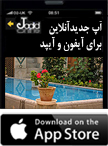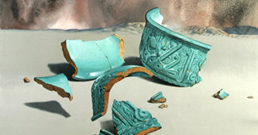Aydin Aghdashlou is one of the most celebrated painters in Iran today, who has been at the heart of artistic life in Tehran for some forty years. The course of his career illustrates the problems and frustrations, the high-points and troughs, experienced by artists both before and after the Revolution, and it shows his own resilience in being able to survive and still find inspiration in the different aspects of the Persian cultural heritage, as well as in his continual search for new forms of creativity and experimentation.
His parents were from an Azarbaijani background, and had fled fromBaku when the Bolsheviks took control. After his father’s death, when Aydin was eleven years old, the family moved from Rasht to Tehran where he began his formal education. But from an early age, it was clear that his gifts lay in a different direction than conventional academic studies. He had started to paint when he was five, and sold his first painting by the time he was only fourteen. Enrolment at the prestigious Fine Arts Faculty at Tehran University seemed the obvious next step in his career, but he did not respond well to the teaching there. He was too individualistic and too creative to accept the strictly conventional instruction that prevailed in art education in Tehran in the early 1960’s.
He was determined to search for his own path and find another kind of inspiration. This led to years of exploration and experiment, when he tried his hand at many different kinds of artistic expression in different media and a variety of artistic styles. For a time he closely imitated the Renaissance masters, copying their paintings with great care and precision, then partially defacing them to represent the destruction of earlier values. If, as he claims, he always tried to act as ‘the visual conscience of the age’, in the great series called ‘Memories of Destruction’ on which he had embarked in the 1970’s, he seemed to be saying something of importance about Iranian society in the last decade of Pahlavi rule. Yet at the same time he had become part of the artistic establishment and given a role in the supervision of exhibitions, the purchase of artworks from abroad, the curatorship of a new museum, and also in art education.
After the Islamic Revolution, it was noticeable that different motifs appeared in his paintings. He made use of his earlier interest and skill in traditional medieval Persian miniature painting, in portraiture, in tile work, gilding and calligraphy. At the same time he began to use more traditional Islamic and Persian themes, especially those of sacrifice, death and martyrdom, deeply influenced as he was by the long years of the Iran-Iraq war and the loss of so many young lives.
Now, approaching his seventieth year, he has lost none of his creative power. He is still exploring new avenues for his extraordinary originality – in film, animation, T.V. documentaries, art criticism, graphic design – and, above all, in painting where he has remained faithful to his distinctively individual style of the use of gouache. He is still active in teaching, writing, running workshops, producing TV programmes and lecturing in universities, and he has recently published a collection of his articles.
In this multimedia package we are given a chance to catch glimpses of what this prolific and outstanding artist considers significant in his life, whilst being guided around his home and seeing his personal collection of paintings as well as the artefacts from which he has drawn inspiration.


